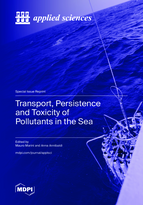Transport, Persistence and Toxicity of Pollutants in the Sea
A special issue of Applied Sciences (ISSN 2076-3417). This special issue belongs to the section "Environmental Sciences".
Deadline for manuscript submissions: closed (30 November 2021) | Viewed by 26372
Special Issue Editors
Interests: chemical processing in soil; groundwater and sea water of organic and inorganic compounds and pollutants; biogeochemical processes in the sea water column and in the sediment; interactions of pollutants and xenobiotics in marine sediments and in the fishes
Special Issues, Collections and Topics in MDPI journals
Interests: analytical chemistry, voltammetry for environmental analysis; atomic absorption spectroscopy; gas chromatography–mass spectrometry; inductively coupled plasma – mass spectrometry; environmental monitoring; heavy metals and organic contaminants in marine organisms; trace elements in seawater and marine sediments; heavy metals in insects; mineral water; river water
Special Issues, Collections and Topics in MDPI journals
Special Issue Information
Dear Colleagues,
This Special Issue will describe the path of pollutants transported to the sea from the mainland and how they accumulate in the marine environment and organisms. It is also important to define the route of the metabolites and their behavior, whether decomposition or accumulation. This will contribute to increasing the knowledge on the dangers of pollutants that reach the sea and their fate once they enter the marine food chain. This Special Issue will also improve information about the pollutant load in the sea during all the seasons, due to the contribution of rivers, rainfall, etc., and the relative influence on marine organisms.
These papers will increase the knowledge of marine environment pollution, marine organism resilience to pollutants and their contamination.
Some topics of interest to be covered by the Special Issue include, but are not limited to:
- Implications of anthropogenic effects on the coastal environment and seabed;
- How climate changes modify surface water regimes and if they affect the runoff of contaminants at sea;
- Pollutants in sediments and marine organisms;
- Seasonal variations of pollutants in the sea;
- Estuarine pollution and the influence on seawater contamination.
Prof. Dr. Mauro Marini
Prof. Dr. Anna Annibaldi
Guest Editors
Manuscript Submission Information
Manuscripts should be submitted online at www.mdpi.com by registering and logging in to this website. Once you are registered, click here to go to the submission form. Manuscripts can be submitted until the deadline. All submissions that pass pre-check are peer-reviewed. Accepted papers will be published continuously in the journal (as soon as accepted) and will be listed together on the special issue website. Research articles, review articles as well as short communications are invited. For planned papers, a title and short abstract (about 100 words) can be sent to the Editorial Office for announcement on this website.
Submitted manuscripts should not have been published previously, nor be under consideration for publication elsewhere (except conference proceedings papers). All manuscripts are thoroughly refereed through a single-blind peer-review process. A guide for authors and other relevant information for submission of manuscripts is available on the Instructions for Authors page. Applied Sciences is an international peer-reviewed open access semimonthly journal published by MDPI.
Please visit the Instructions for Authors page before submitting a manuscript. The Article Processing Charge (APC) for publication in this open access journal is 2400 CHF (Swiss Francs). Submitted papers should be well formatted and use good English. Authors may use MDPI's English editing service prior to publication or during author revisions.
Keywords
- Marine Pollutants
- Marine Chemistry
- Water Chemistry
- River Runoff
- Effects Climate Changes
- Cloudburst
- Fish Contaminants
- Seabed Contaminants







